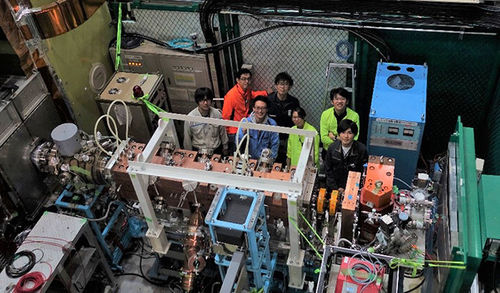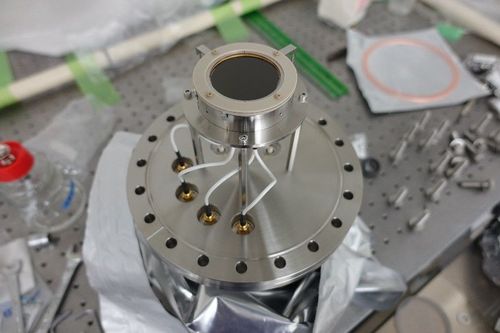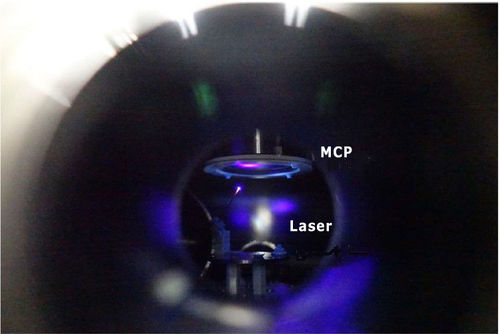Yuki Sue and Mai Yotsuzuka, graduate students at Nagoya University, develop bunch-width monitor for beams, indispensable for realizing high-quality muon beams
At J-PARC, preparations are in progress for an experiment to achieve simultaneous, high-precision measurement of properties of the muon elementary particle-the anomalous magnetic moment (g-2) and electric dipole moment (EDM) (J-PARC E34 experiment). R&D led by numerous graduate students is being conducted for this purpose, and results achieved by graduate students from the Nagoya University High Energy Physics Laboratory (NUHEPL) were recently published as a journal article. We spoke with the first author Yuki Sue (1st year, doctoral program) and second author Mai Yotsuzuka (1st year, master's program). (Interview conducted by the J-PARC Public Relations Section)
Experimental Group, Mr. Sue (top right) and Ms. Yotsuzuka (second from right in front row)
Microchannel plate (MCP) that Mr. Sue and Ms. Yotsuzuka developed. It detects a muon which enters the surface of MCP (The black circle plate shown in the above picture.), and monitors to measure the bunch width of a muon beam.
■ Background thus far
To precisely measure the muon g-2/EDM, the key point is to create a high-quality muon beam that is controlled in terms of spatial and temporal spread. To achieve this, the generated muon beam must be decelerated (cooled) once, and then accelerated again. For the E34 experiment, muon cooling/acceleration technologies and detectors are being developed to attain the world's highest precision using a muon beam of unprecedented high quality. The group has already completed a prototype detector, and demonstrated stable operation (+). In addition, techniques have been successfully developed for cooling muons at high efficiency roughly 10 times greater than existing techniques (*). Since then, acceleration experiments have been conducted three times at the test muon beamline of J-PARC's Materials and Life Science Experimental Facility (MLF). In the first experiment, an experiment accelerating negative muonium ions (**+) was successfully completed through the development of a new negative hydrogen ion source for adjusting the instrument that accelerates muons (**). In the second experiment, the spatial distribution of the muon beam after acceleration was successfully measured with a monitor. In the results of the third experiment (the current results), the time width of the beam was successfully measured by developing a monitor for measuring the time distribution of a muon beam after acceleration.
(+) KEK's IPNS News (Japanese) https://www2.kek.jp/ipns/ja/post/2019/06/20190610/
https://www2.kek.jp/ipns/ja/post/2019/06/20190612/
(*) KEK Press Releases (Japanese) https://www.kek.jp/ja/newsroom/2014/09/18/1400/
(**) J-PARC homepage (Japanese) http://j-parc.jp/c/topics/2019/06/11000271.html
(**+) J-PARC News (English) http://www.j-parc.jp/c/en/topics/2018/01/31000329.html
What is this "monitor for measuring the time distribution of a muon beam" you've developed for this work?
The beam through the beam pipe of the J-PARC accelerator flows in clusters, not uniformly. That is, if one looks at a certain location, a cluster passes by at a certain time, and after a certain time interval, the next cluster flows by. This sort of beam is called a "pulsed beam." If a pulsed beam is graphed, with time as the horizontal axis and beam intensity as the vertical axis, the result is as indicated in the diagram. A monitor was developed to measure the beam distribution in time.
In the E34 experiment, a muon beam is accelerated using 4 types of accelerating cavity in total. At the first cavity, a muon pulsed beam with a pulse width of 10ns (nanoseconds; 1 ns = 10-9 s) is accelerated by injecting into the cavity, as indicated in the diagram. When the beam is accelerated and emerges from the cavity, it comes out separated into about 4 clusters with a spacing of 3ns (***). If timing is not precisely adjusted between the accelerating cavity and each cluster with pulse width of about 100ps (picoseconds; 1 ps = 10-12 s), then acceleration cannot be done smoothly and the high-quality beam needed for precise measurement of muon g-2/EDM is not possible. Thus, the monitor is used to measure this pulse width.
(***) In the high-frequency accelerating cavity, high-frequency electric fields are alternately applied to electrodes (light blue) in the pattern + - + - ... as shown in the diagram below (left). When positive muons accelerated in the E34 experiment pass through the gap between two electrodes, and a high-frequency magnetic field is applied so the electrode on the left side is + and the electrode on the right side is -, then the positive muon is accelerated to the right in the diagram. If the frequency is controlled so the + and - of the high-frequency electric field invert when the positive muon moves into the next gap, then the positive muon can be constantly accelerated.
The frequency of the high-frequency electric field applied to the 1st-level accelerating cavity in the E34 experiment is 324 MHz, and thus the period of the waves is 1/324 MHz = 3.09 ns. If, for example, the accelerating cavity is designed so that positive muons are accelerated with an electric field of the phase indicated by the ● mark in the diagram below (right), then positive muons arriving at a velocity slower than the designed velocity will be accelerated by a stronger electric field and speed up, and positive muons arriving at a velocity faster than the designed velocity will be accelerated by a weaker electric field and slow down. This makes it possible to achieve beam clusters which converge on a period of 3.09 ns.
So you successfully measured the time distribution of a muon beam with the recently developed monitor?
Yes. There are two main points in the results of our recently published article.
First is the fact that we brought a 1st-level accelerating cavity tester (half of actual length) and beam monitor into the test muon beamline of the MLF, and successfully measured the time distribution of the beam after acceleration. However, in the recent test, there was a substantial difference in conditions from the actual E34 experiment. The pulse width of the beam cluster divided into 3 ns intervals after acceleration was considerably wider than in the actual E34 experiment, where the width is about 500 ps (= 0.5 ns). We were able to measure this pulse width with the monitor, and a value matching the simulation was obtained.
Secondly, it was confirmed that a time resolution of 65 ps (= 0.065 ns) can be achieved. This was determined by testing-in the laboratory, not the J-PARC beamline-whether or not the monitor can handle measurement of pulsed beams with a narrower width. In the actual E34 experiment, there is no need to measure pulse widths of a few tens of ps, but a time resolution approaching that has been achieved.
The ability to measure at a high time resolution is a key point, isn't it? How was that achieved?
The monitor employs a detector called a microchannel plate (MCP) as the detector for achieving high time resolution. Countless small holes of diameter 12 μm (micrometers; 1 μm = 10-6 m) are provided in the plate surface-not perpendicularly, but at an angle-and high voltage is applied between the two sides of the plate. When a muon enters a hole, multiple electrons are produced due to collisions with the hole walls. Those electrons in turn are attracted by the voltage and strike the wall, generating multiple electrons again so the electrons rapidly increase in number. These electrons are read as an electrical signal. The MCP itself is commercially available, but to achieve the high time resolution needed for the experiment, there were major development issues such as devising the signal reading mechanism.
Was development difficult?
(Sue)
Since we had to prepare in time for experiments using the J-PARC beam, it was quite challenging in terms of timing. For the monitor signal reading circuit, we achieved the target time resolution in a test period of just 2 months by carrying out development using a circuit developed in our laboratory for the TOP counter of the Belle II experiment (****+). In addition to the monitor, we also developed an instrument called a "buncher" for converging the beam into short pulses (****), but the fabrication period was tight, and coordination with vendors was tough. The period from delivery to the experiment at J-PARC was short, and performance of the equipment was checked in a hurry. We made time in an extremely tight schedule, and were able to finish in time, so it was a good experience. We also carried out a simulation of the entire beamline and accelerating cavity on our own, and learned a great deal.
(****)
M. Otani and Y. Sue (corresponding authors) et al., "Compact buncher cavity for muons accelerated by a radio-frequency quadrupole", Nucl. Inst. Meth. Phys. Res. Sec. A Volume 946, 1 December, 2019, 162693
(****+)
K. Inami (Belle-II PID Group), "TOP counter for particle identification at the Belle II experiment", Nucl. Inst. Meth. Phys. Res. Sec. A Volume 766, 5, 2014.
(Yotsuzuka)
I was in charge of improving the time resolution of the monitor. Muons can't be used when testing the performance of a monitor in the university laboratory so electrons (photoelectrons) are generated instead using a laser. We struggled because we were unable to achieve high time resolution, as we originally thought we might, by using a method of detecting photoelectrons generated by irradiating a crystal surface with a picosecond pulsed laser. While experimenting, however, a new path was opened up when we found that high time resolution can be achieved by using photoelectrons produced by directly irradiating the MCP surface with a laser. We were able to improve time resolution just in time for the experiment at J-PARC, and furthermore, we were able to achieve time resolution sufficient to handle pulse widths shorter than the experiment at J-PARC.
Laser irradiation on MCP surface.
Going forward, will you continue preparations for this experiment?
(Sue)
The results published in the journal article are from work during my master's course, and since entering the doctoral course, I've actually been working on a different research theme. I'm developing the trigger system and conducting physics analyses for the Belle II experiment underway at the KEK Tsukuba Campus. Thus far, I've been engaged in development and testing of the monitor presented here, as well as various other projects, and that has deepened my knowledge of accelerators tremendously. Making use of that, I want to achieve results in my doctoral course not only in development and testing of instruments, but also in physical analysis. In fact, results obtained in this physical analysis will enable improved precision in theoretical prediction of muon g-2. Therefore, I'm currently tackling the riddle of muon g-2 using an approach different from that during my master's course. The first year of my doctoral course is about to end, but I feel the knowledge of accelerators I have acquired thus far has already been useful.
Yotsuzuka will be taking over from me in development of a muon beam monitor. We have closed in on the time resolution needed for the E34 experiment, but we need one final push. We are in the same laboratory, so even now I give her advice. I too want to do one more piece of work in this experiment, but I can't move forward with two research themes at once, and I'm a bit frustrated about that.
(Yotsuzuka)
At present, I'm working to develop a beam transport line for the low energy section to realize a low-emittance muon beam in the E34 experiment. Four types of linacs are used in the E34 experiment, and therefore it is crucial to perform beam adjustment (matching) between different accelerators so the beam does not spread during acceleration. In the low energy section, beam diagnosis is carried out using the recently-developed monitor, and thus the required precision for the monitor is being estimated while designing the optical system of the beam transport line. Monitor development is also continuing, and I aim to attain the required time resolution and carry out detailed performance evaluation through approaches like position calibration.
■ Publication
Journal name: PHYSICAL REVIEW ACCELERATORS AND BEAMS Volume 23, 022804 - Published 12 February 2020
Article: Development of a bunch-width monitor for low-intensity muon beam below a few MeV
Authors: Yuki Sue, Mai Yotsuzuka, Kenta Futatsukawa, Kazuo Hasegawa, Toru Iijima, Hiromi Iinuma, Kenji Inami, Katsuhiro Ishida, Naritoshi Kawamura, Ryo Kitamura, Yasuhiro Kondo, Tsutomu Mibe, Yasuhiro Miyake, Takatoshi Morishita, Yuga Nakazawa, Masashi Otani, Naohito Saito, Koichiro Shimomura, Yusuke Takeuchi, Takahiro Ushizawa, Takayuki Yamazaki, and Hiromasa Yasuda
DOI: 10.1103/PhysRevAccelBeams.23.022804
URL: https://journals.aps.org/prab/abstract/10.1103/PhysRevAccelBeams.23.022804






